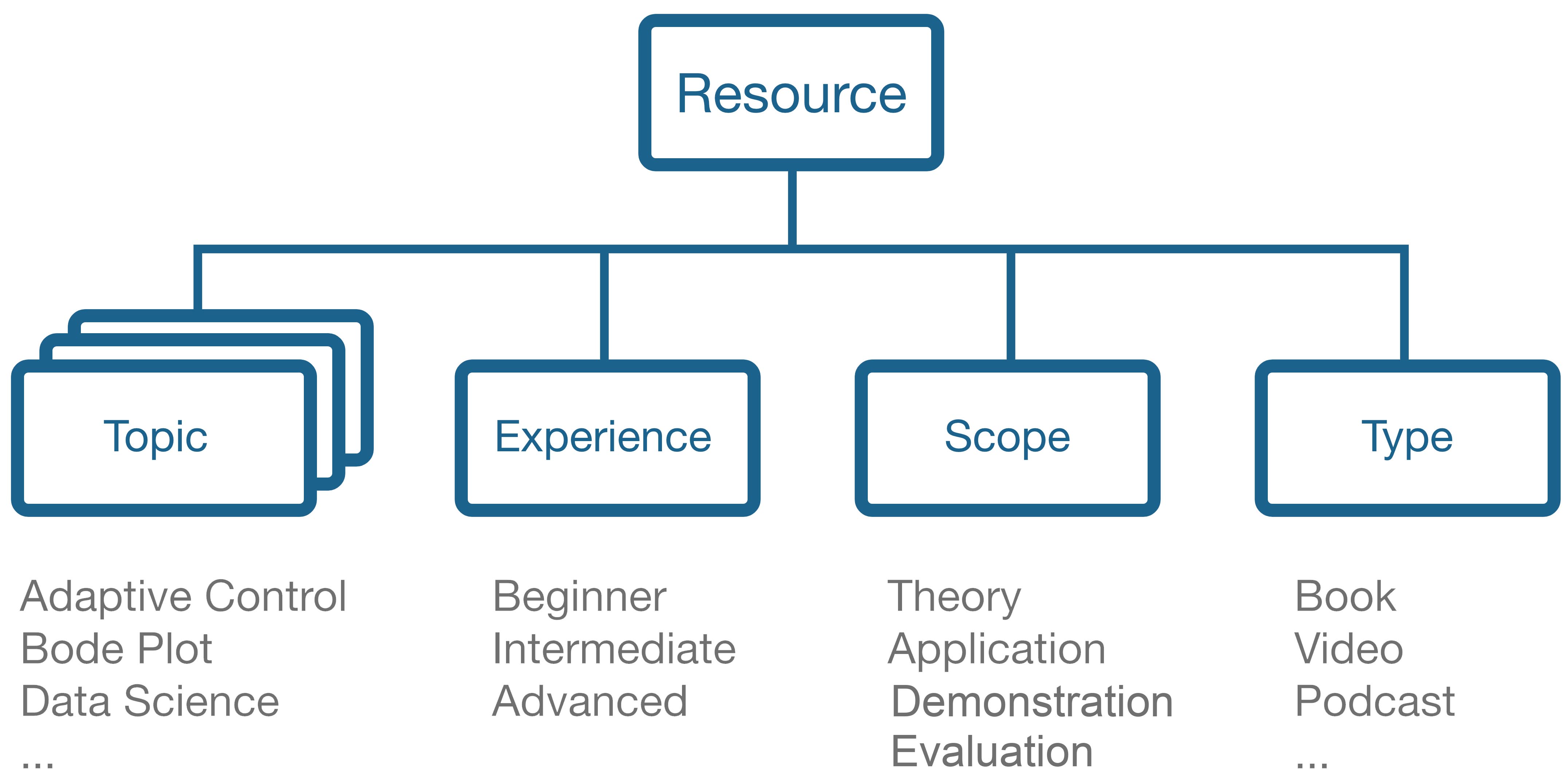The three content types
Resourcium is built around three different types of content: topics, resources, and journeys.
-
Topics - A topic is an individual subject, concept, or idea that a learner might be interested in. It's probably easiest to think of a topic as a Wikipedia page. If there's a page for it, then it's a topic. The purpose of topics is to provide a way to group resources that all are focused on describing the same phenomenon. For example, resources and journeys within the "PID Controller" topic are all attempting to explain PID control at some level. Topics can be hierarchical as well. For example, "Linear Algebra" is a parent topic to "State Space Representation" which itself is a parent topic to "Linear Quadratic Gaussian (LQG) Control".
For now, you can browse the existing topics in a flat list on the Explore page. Eventually, topics (and the hierarchy and learning map that relates them to each other) will be used to navigate to and discover resources and journeys rather than relying on searching and filtering to find them.
- Resources - Resources are individual pieces of educational content. A resource could be something that covers multiple topics like a textbook or describes a single topic like a video lecture or blog post. It’s not necessary that a resource needs to be able to stand on its own and consist of a complete story. For example, a GIF of an inverted pendulum might not describe the dynamics of the system, or how to control it, but that GIF is a resource because it could be used to demonstrate the end result of an algorithm that you learn from other resources. The combination of resources can then take the user on a better educational journey.
- Journeys - Journeys are a collection of resources ordered in a way that makes it much easier to learn a particular topic.
There are three main audiences for which we think journeys will be useful:
- For learners who don’t want to search through different resources on their own but would rather follow a path that was curated and recommended by someone else.
- For educators who are looking to build out their course content by quickly seeing how other people approach teaching the same topic.
- For content creators who want to tell part of a story and point their audience to existing resources to fill in the rest. A journey could organize the existing resources along with the newly-created resource to tell a complete story.
Resource taxonomy
Each resource is labeled according to a defined taxonomic scheme. This categorization is intended to improve the way you search for resources and increase the chance that you find the resource that will meet your needs.

-
Topic - This field describes the main educational focus of the resource - what the resource is trying to explain. A resource can have multiple topics but only if it is truly trying to explain multiple things (e.g. a textbook). A resource that is focused on PID control should only be tagged with the "PID control" topic even if the resource casually mentions feedback or transfer functions. If it's not explicitly trying to explain feedback or transfer functions then they are not topics for that resource.
-
Experience - This field describes how much knowledge about a topic a user needs to have to be able to fully understand the resource. Note that this isn't general prerequisite knowledge, just knowledge about the specific topic that is being covered in the resource. For example, to understand PID control at almost any level (beginner, intermediate, and advanced), you need general knowledge of feedback and transfer functions. However, for a beginner PID control resource, you don't need to have any experience with PID control in order to understand the material.
- Beginner - Requires no prior knowledge of the topic. This includes introductory resources to the topic that provide fundamental knowledge.
- Intermediate - Requires an understanding of the fundamentals within the topic. This includes resources that expand beyond fundamental knowledge but does not require deep expertise in a topic.
- Advanced - Requires a deep understanding of the topic. This includes resources that cover the latest research and other cutting-edge developments.
-
Scope - This field describes the main focus of the resource - what kind of knowledge the user should receive from the resource.
- Theory - Resource tends to be more abstract and generalized. The focus is on learning new concepts, contemplating, and thinking about the problem.
- Application - Resource tends to be more specific and tailored towards applying the topic to real situations. Often these resources provide ways for the user to actively participate; for example by writing their own code or using hardware.
- Demonstration - Resource tends to focus on showing the end result of a concept rather than explaining it. These might be short GIFs, images of data, or other videos that show off student projects, working demonstrations, and other results. The resource doesn't necessarily have to explain what is being shown because the resource can be combined with other application or theory resources to tell a fuller story.
- Evaluation - Resource tends to focus more on challenging and testing the knowledge of the user. These might be exams, simple problem sets, or competitions.
-
Type - This field describes the media format of the resource.
- Video
- Book
- Forum
- App
- Course
- Project
- Hardware
- Software
- Peer Reviewed Paper
- Article
- Podcast
- Image
- ...
